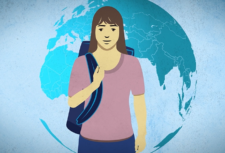Disclaimer: This article is more than 17 years old, and may not include the most up-to-date information or statistics. Please verify information with more recent sources as needed, and if you have any questions contact our Press Office.
16 March 2007
At least 12 million people worldwide, including in the UK, are in slavery 200 years after Britain abolished the Transatlantic Slave Trade. A striking new photo exhibition — Forgotten But Not Gone: Slavery and resistance 200 years after abolition — exposes the global realities of slavery today, opens on 21 March at the.gallery@oxo, South Bank, London.
Photojournalist Pete Pattisson, in collaboration with Anti-Slavery International, reveals the men, women and children in slavery in India, Haiti, Ghana, Burma, Ireland and the UK through photographs and intimate stories. This exhibition is a compelling reminder that slavery is exploitation in its most extreme form and does not discriminate by age, race or sex.
Even though slavery is illegal under international law, no region is free from this abuse and slavery is found in most countries. Today, slavery can even be found in the countries that formed the Transatlantic slave triangle. In Haiti, the first country to free itself from slavery, at least 200,000 children are enslaved as domestic workers. They work 18-hour days, suffering extreme exploitation and abuse. As child domestic Stephanie Sanon, 14, said, “The only time I get to rest, is when I fall asleep.”
But the spirit of resistance that brought an end to the Slave Trade lives on. In India, which has more slaves than any other country in the world, bonded labourers are using the law to free themselves. Meetu Singh, who spent 10 years working without pay for a landlord said, “I would rather hang myself than go back into bondage.”
Aidan McQuade Director of Anti-Slavery International says: “Pete Pattisson’s photographs are a sobering reminder on the bicentenary of Britain’s abolition of the Slave Trade of the nature of slavery in the world today. For every single person affected, slavery represents a singularly brutal crushing of their hopes and devastation of their lives. It is vital that governments around the world make eradicating slavery a priority and implement the laws that can achieve this. There is no excuse for what is frequently seen as an historical phenomenon to be a 21st century reality.”
NOTES TO EDITORS:
- Anti-Slavery International is the world’s oldest human rights organisation and campaigns for the eradication of slavery, exposing current cases, supporting local organisations to release the minimum 12.3 million people in slavery, and the implementation of international laws against slavery. For further information please contact Paul Donohoe, Anti-Slavery International’s Press Officer, on 020 7501 8934 or email p.donohoe@antislavery.org
- The exhibition is open from 21 March-15 April, 11am-6pm daily, the.gallery@oxo; Oxo Tower Wharf, Bargehouse Street, South Bank, London SE1. Admission FREE. Nearest train/tube: Blackfrairs, Waterloo, Southwark. Information 020 7401 2255; http://www.petepattisson.com and http://www.oxotower.co.uk
- Digital images are available on request from Pete Pattisson, on 07914373661 / pete@petepattisson.com
- On 25 March, the anniversary of Parliament’s passing the slave trade abolition act, there will be a free talk at the.gallery@oxo by Pete Pattisson from 2-3pm.





